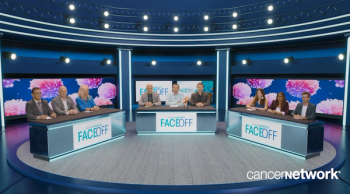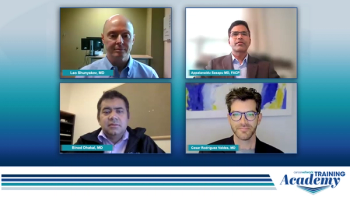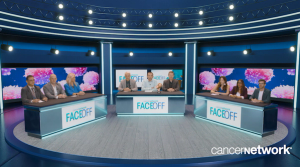Cesar Rodriguez Valdes, MD
Articles by Cesar Rodriguez Valdes, MD

Clinical Scenario: Implementation of Bispecific Therapy for Relapsed Refractory Multiple Myeloma in a Community Center
ByAjai Chari, MD,Thomas G. Martin, MD,Jens Hillengass, MD, PhD ,Beth Faiman PhD, MSN, APN-BC,BMTCN, AOCN, FAAN, FAPO ,Louis Williams, MD,Shebli Atrash, MD ,Donna Catamero, ANP-BC, OCN, CCRC,Cesar Rodriguez Valdes, MD ,Shambavi Richard, MD Panelists discuss how community centers can effectively implement bispecific antibody therapy for patients with relapsed/refractory multiple myeloma, addressing challenges such as staff training, patient monitoring, and managing potential adverse events in a non-academic setting.

Panelists discuss how addressing unmet needs and future directions for enhancing bispecific therapy care transitions in multiple myeloma requires focusing on standardized protocols, technology integration, personalized patient support, and continuous education for both patients and healthcare providers across academic and community settings.

Clinical Scenario: A 58-Year Old Woman with Relapsed Refractory Mutiple Myeloma, post-ASCT, MRD-negative, on Bispecific Therapy
ByAjai Chari, MD,Thomas G. Martin, MD,Jens Hillengass, MD, PhD ,Beth Faiman PhD, MSN, APN-BC,BMTCN, AOCN, FAAN, FAPO ,Louis Williams, MD,Shebli Atrash, MD ,Donna Catamero, ANP-BC, OCN, CCRC,Cesar Rodriguez Valdes, MD ,Shambavi Richard, MD Panelists discuss how to approach treatment decisions and management strategies for a 58-year-old woman with relapsed/refractory multiple myeloma who is post-autologous stem cell transplant, MRD-negative, and currently receiving bispecific antibody therapy, considering factors such as prior treatments, response duration, and long-term treatment goals.

Dosing Interval and Considerations for Bispecifics Combination in Relapsed Refractory Multiple Myeloma
ByAjai Chari, MD,Thomas G. Martin, MD,Jens Hillengass, MD, PhD ,Beth Faiman PhD, MSN, APN-BC,BMTCN, AOCN, FAAN, FAPO ,Louis Williams, MD,Shebli Atrash, MD ,Donna Catamero, ANP-BC, OCN, CCRC,Cesar Rodriguez Valdes, MD ,Shambavi Richard, MD Panelists discuss how optimizing dosing intervals and carefully considering combination strategies for bispecific antibodies in relapsed/refractory multiple myeloma could enhance treatment efficacy while managing toxicities and improving patient quality of life.

Panelists discuss how optimizing patient reintegration into community care after receiving bispecific therapy for multiple myeloma at academic centers requires a coordinated, patient-centered approach involving clear communication, standardized transition protocols, ongoing education, and collaborative care models between academic and community oncologists.

Panelists discuss how enhancing communication between academic and community oncologists during the referral and treatment process for multiple myeloma patients requires a multifaceted approach involving standardized protocols, technology integration, regular collaborative meetings, and shared decision-making to ensure seamless patient care and optimal outcomes.

Sequencing Therapies in Relapsed Refractory Multiple Myeloma: Bispecifics and CAR T-Cell Therapies
ByAjai Chari, MD,Thomas G. Martin, MD,Jens Hillengass, MD, PhD ,Beth Faiman PhD, MSN, APN-BC,BMTCN, AOCN, FAAN, FAPO ,Louis Williams, MD,Shebli Atrash, MD ,Donna Catamero, ANP-BC, OCN, CCRC,Cesar Rodriguez Valdes, MD ,Shambavi Richard, MD Panelists discuss how the optimal sequencing of bispecific antibodies and CAR T-cell therapies in relapsed/refractory multiple myeloma could maximize treatment efficacy and improve patient outcomes in this challenging disease setting.

OPTec: Outpatient Step Up Administration of Teclistamab: Implications in Real-World Practice
ByAjai Chari, MD,Thomas G. Martin, MD,Jens Hillengass, MD, PhD ,Beth Faiman PhD, MSN, APN-BC,BMTCN, AOCN, FAAN, FAPO ,Louis Williams, MD,Shebli Atrash, MD ,Donna Catamero, ANP-BC, OCN, CCRC,Cesar Rodriguez Valdes, MD ,Shambavi Richard, MD Panelists discuss how the OPTec study, which explores outpatient step-up administration of teclistamab, could impact real-world practice by potentially improving patient convenience and reducing healthcare resource utilization in the treatment of multiple myeloma.

Panelists discuss how comprehensive long-term monitoring protocols for patients who have received bispecific therapy typically involve regular follow-ups, standardized testing schedules, and clear communication channels between academic centers and community practices to manage potential complications and adverse events.

Panelists discuss how determining a patient's readiness to transition back to community oncology care after bispecific therapy involves assessing multiple factors including treatment response, toxicity resolution, overall stability, and the community practice's capabilities.

Prophylactic Tocilizumab in MajesTEC-1 for the Reduction of CRS
ByAjai Chari, MD,Thomas G. Martin, MD,Jens Hillengass, MD, PhD ,Beth Faiman PhD, MSN, APN-BC,BMTCN, AOCN, FAAN, FAPO ,Louis Williams, MD,Shebli Atrash, MD ,Donna Catamero, ANP-BC, OCN, CCRC,Cesar Rodriguez Valdes, MD ,Shambavi Richard, MD Panelists discuss how prophylactic use of tocilizumab in the MajesTEC-1 trial may reduce the incidence and severity of cytokine release syndrome (CRS) in patients receiving bispecific antibody therapy for multiple myeloma, potentially improving treatment safety and tolerability.

Bispecific Antibody Combinations In Relapsed Refractory Multiple Myeloma: RedirecTT-1 Follow-Up
ByAjai Chari, MD,Thomas G. Martin, MD,Jens Hillengass, MD, PhD ,Beth Faiman PhD, MSN, APN-BC,BMTCN, AOCN, FAAN, FAPO ,Louis Williams, MD,Shebli Atrash, MD ,Donna Catamero, ANP-BC, OCN, CCRC,Cesar Rodriguez Valdes, MD ,Shambavi Richard, MD Panelists discuss how the follow-up results from the RedirecTT-1 study provide insights into the long-term efficacy and safety of bispecific antibody combinations in treating relapsed/refractory multiple myeloma, potentially shaping future treatment approaches for this challenging disease.

Panelists discuss how referral types for multiple myeloma patients vary widely, including newly diagnosed cases, relapsed/refractory disease, and specific therapy considerations like bispecifics, with processes differing between in-state and out-of-state referrals due to logistical and insurance factors.

Panelists discuss how the evaluation and treatment initiation processes for non-BCMA targeted bispecifics and BCMA-targeted bispecifics share core similarities in patient assessment and care coordination, but differ in specific premedication protocols, dosing strategies, and side effect management.

Bispecific Antibody Combinations In Relapsed Refractory Multiple Myeloma: TRIMM-2 Study
ByAjai Chari, MD,Thomas G. Martin, MD,Jens Hillengass, MD, PhD ,Beth Faiman PhD, MSN, APN-BC,BMTCN, AOCN, FAAN, FAPO ,Louis Williams, MD,Shebli Atrash, MD ,Donna Catamero, ANP-BC, OCN, CCRC,Cesar Rodriguez Valdes, MD ,Shambavi Richard, MD Panelists discuss how the TRIMM-2 study explores the potential of combining bispecific antibodies to enhance treatment efficacy in patients with relapsed/refractory multiple myeloma, potentially offering a novel therapeutic strategy for this difficult-to-treat condition.

Talquetamab, a GPRC5DxCD3 bispecific antibody (BsAb), for Relapsed Refractory Multiple Myeloma: MonumenTAL-1 Data and Implications
ByAjai Chari, MD,Thomas G. Martin, MD,Jens Hillengass, MD, PhD ,Beth Faiman PhD, MSN, APN-BC,BMTCN, AOCN, FAAN, FAPO ,Louis Williams, MD,Shebli Atrash, MD ,Donna Catamero, ANP-BC, OCN, CCRC,Cesar Rodriguez Valdes, MD ,Shambavi Richard, MD Panelists discuss how Talquetamab, a novel GPRC5DxCD3 bispecific antibody, shows promising results in treating relapsed/refractory multiple myeloma based on the MonumenTAL-1 trial data, potentially offering a new therapeutic option for this challenging patient population.

Panelists discuss how academic centers approach the initial consultation and evaluation process for patients referred for bispecific therapy from community practices.

Panelists discuss how transitioning patients with multiple myeloma from community to academic settings faces challenges including communication gaps, differences in treatment approaches, patient reluctance, and logistical hurdles.

Panelists discuss how patient-specific factors such as disease status, overall health, support systems, and treatment history are crucial considerations when determining readiness for potential transition to community settings for ongoing care.

Panelists discuss how the initial process of identifying and referring potential candidates for bispecific therapy from the community setting to an academic center involves careful patient assessment, clear communication channels, and established referral protocols to ensure timely and appropriate treatment initiation.

Panelists discuss how multiple myeloma care faces challenges including patient reluctance to seek treatment at academic centers, complex treatment landscapes, and the need for improved coordination between community and academic physicians.

Panelists discuss how collaborative care settings for multiple myeloma patients often lead to improved outcomes compared to non-collaborative approaches, citing factors such as access to specialized expertise, coordinated treatment plans, and comprehensive patient support.

Panelists discuss how streamlining the referral process for multiple myeloma patients can significantly reduce treatment initiation.

Panelists discuss how effective collaboration, care coordination, and communication between academic and community physicians are crucial for ensuring seamless transitions and high-quality care for patients with multiple myeloma.






